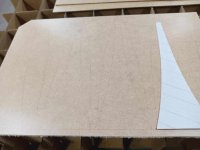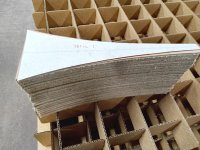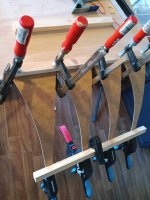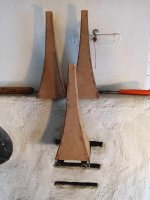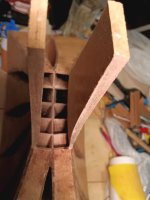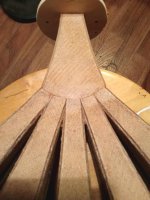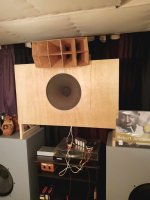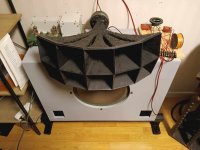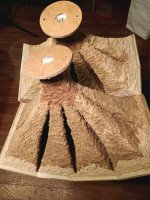I am pretty sure I could not tell the difference...it has been a long time since I listened to the multicell setup. Even without the foam, I could not see any artifacts in the measurements that could be attributed to the horn. My thought is that the thin plastic wall is pretty damped by its material properties - at least for the SPL I listened at. It is soft, but not resonant. Maybe at higher SPL, there could be a difference.
Nothing as fancy as an Altec, but at least an old Fane 15" 15 ohms driver. Somewhat similar to the one on this link, but not exactly identical: https://www.vintage-radio.net/forum/showthread.php?t=86026
A few construction notes: Due to lack of tools and a proper workspace I didn't use Petters method with routing the cell sides against a mold to get 45 degree edges. Instead I just cut them out one by one with the bandsaw as exactly as I could, then bundled them together and sanded them. This turned out surprisingly well, although the assembly was a bit of a mess. Pre-bending each cell side (masonite bends easily if you brush some water on it) helped a lot, then I used a hot glue gun to "spot weld" the sides together before applying PVA glue. Once the PVA glue had set, I cut away the blobs of hot glue and filled the joints with a "porridge" of PVA glue and masonite dust.
This method works but if anyone wants to build multicell horns I'd definitely recommend Petters method, preferably with a mold made of metal.
This was just something I came up with to entertain myself during slow hours at work, with a low key ambition to build a retro-style mono rig of leftover parts and drivers (which, in turn, is just an excuse to build weird mono tube amps out of odd bits and pieces... )
)
I kind of regret selling my old pair of DIY 15 cell 2" multis, so after the holidays I'm gonna ask a friend who has a CNC router if he can cut out 100+ plywood pieces for me. Not that i need more horns, but I cannot possibly be happy without at least one pair of fat multicells in my listening room.
This method works but if anyone wants to build multicell horns I'd definitely recommend Petters method, preferably with a mold made of metal.
This was just something I came up with to entertain myself during slow hours at work, with a low key ambition to build a retro-style mono rig of leftover parts and drivers (which, in turn, is just an excuse to build weird mono tube amps out of odd bits and pieces...
I kind of regret selling my old pair of DIY 15 cell 2" multis, so after the holidays I'm gonna ask a friend who has a CNC router if he can cut out 100+ plywood pieces for me. Not that i need more horns, but I cannot possibly be happy without at least one pair of fat multicells in my listening room.
Thanks!
So far I've only listened to it with a very simple 6/6dB crossover and an L-pad for the horn. Sounds quite decent by all means, but I'm sure it can get better with a proper crossover and some LCR sorcery to tame the midbass and midrange. Some kind of damping on the horn walls would probably help calming things down a bit too.
Putting the woofer in an open baffle close to the back wall wasn't entirely successful, might rebuild it to an aperiod box later on.
So far I've only listened to it with a very simple 6/6dB crossover and an L-pad for the horn. Sounds quite decent by all means, but I'm sure it can get better with a proper crossover and some LCR sorcery to tame the midbass and midrange. Some kind of damping on the horn walls would probably help calming things down a bit too.
Putting the woofer in an open baffle close to the back wall wasn't entirely successful, might rebuild it to an aperiod box later on.
Hi guys!
Felt crafty and decided to shoot my shot with Pelanj's 3D plans from Thingiverse. The first horn is close to being 100% assembled and I'm so excited to try it out next week.
I've used sikaflex to glue the pieces together and bitumen underbody treatment for cars as acoustic treatment.Actually the same stuff is sold for damping purposes! Feels good and stable. Budget for this was only 20€ per unit.
If I'd make another pair for some friends who also want to make their own sound system I'd like to edit a couple of things in the blueprints. The cell walls are a little bit too thin and makes a wavy shape, something that could be avoided with some kind of criss cross support pattern on the outside. Also good to get the acoustic treatment even and nice!
 Might even do a video tutorial later.
Might even do a video tutorial later.
Felt crafty and decided to shoot my shot with Pelanj's 3D plans from Thingiverse. The first horn is close to being 100% assembled and I'm so excited to try it out next week.
I've used sikaflex to glue the pieces together and bitumen underbody treatment for cars as acoustic treatment.Actually the same stuff is sold for damping purposes! Feels good and stable. Budget for this was only 20€ per unit.
If I'd make another pair for some friends who also want to make their own sound system I'd like to edit a couple of things in the blueprints. The cell walls are a little bit too thin and makes a wavy shape, something that could be avoided with some kind of criss cross support pattern on the outside. Also good to get the acoustic treatment even and nice!
Last edited:
Yes please! I'll have to learn how to use the design software but that'll come in handy for other stuff too.. 😁
For a second pair I'd be interested to modify the horns to be bigger like the Altec 1505, then the cells will definitely need some stronger walls.
Would I also have to redesign the mouth and the length of the driver adapter if I make bigger cells?
For a second pair I'd be interested to modify the horns to be bigger like the Altec 1505, then the cells will definitely need some stronger walls.
Would I also have to redesign the mouth and the length of the driver adapter if I make bigger cells?
- Home
- Loudspeakers
- Multi-Way
- The construction of a multicell horn
